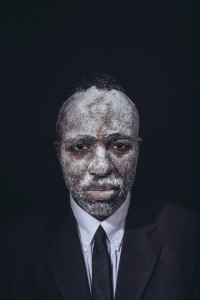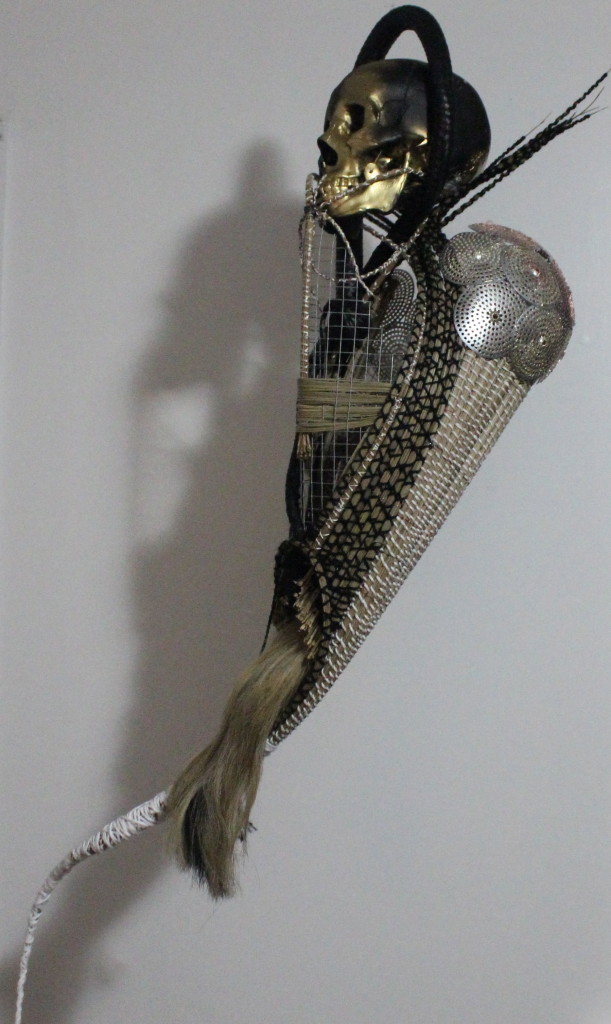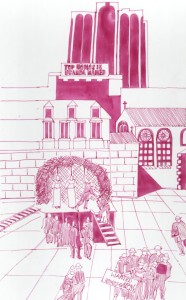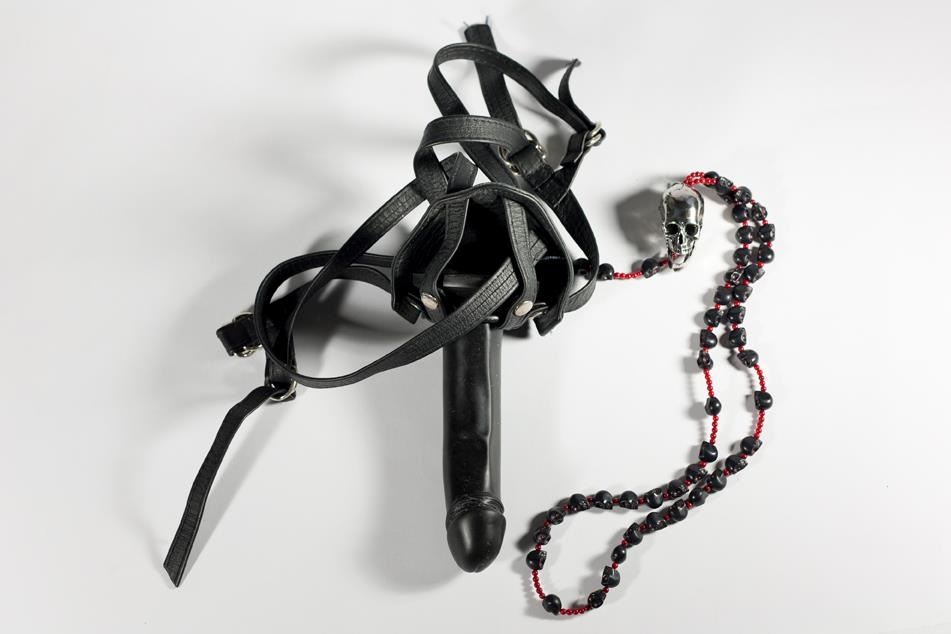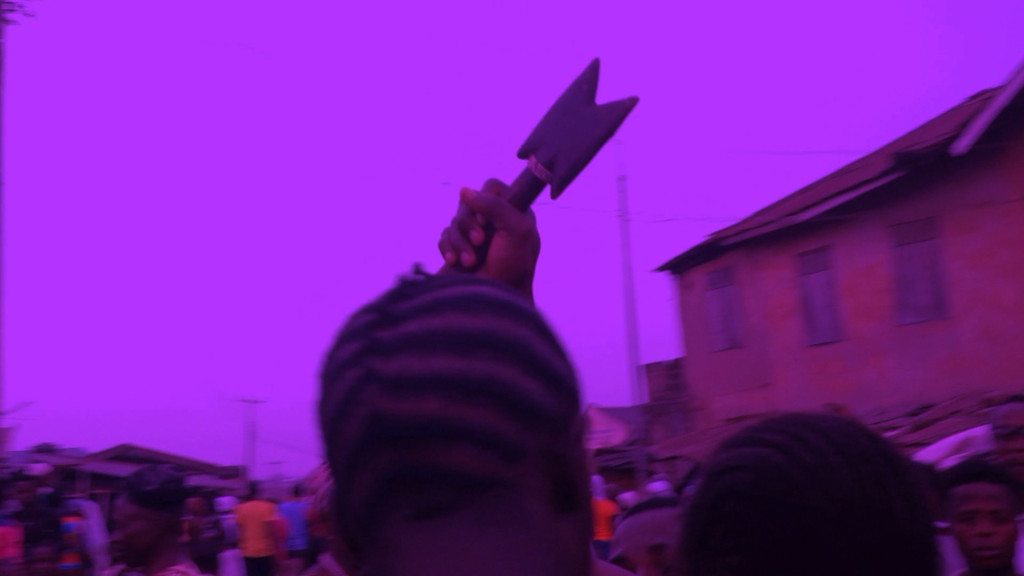
We impose our opinions, our norms and morals onto those others or, even worse, we fight and go to war to basically weep them out or conquer them. Geography, religion, spirituality, traditions, ethnicity, gender, race, sexuality, we human beings have defined many ways to separate ourselves from “the other”. Will we ever actually see, respect and value all that includes humanity? Can art be a tool in this struggle?
Sasha Dees on activism in (gay)art
Abakhaphi at Promise & Gift’s Wedding II, Daveyton, 2013.
Sweet Boys & Butch Girls
Activism in (gay) art
It has always baffled me that in the thousands of years of our existence, humanity has been unable to live with each other in a decent way. What is it that we forget about humanity and create what we call ‘the other’ who then somehow turned into ‘non-human’? We impose our opinions, our norms and morals onto those others or, even worse, we fight and go to war to basically weep them out or conquer them. Geography, religion, spirituality, traditions, ethnicity, gender, race, sexuality, we human beings have defined many ways to separate ourselves from “the other”. Will we ever actually see, respect and value all that includes humanity? Can art be a tool in this struggle?
1.
I met up with Sheldon Scott, a DC based artist. We talked about him growing up in his Gullah/Geechee community that in his time only accepted hetero sexuality. They would call him “Sweet Boy” and that was not meant to be a compliment. Even at an early age of 5 and 6, when sexuality is hardly a reality, folk would say of boys with a feminine presentation: “that boy has sugar in his blood” or “that boy got hit by a Dixie truck” (Dixie Crystal is a brand of sugar).
Blackness has often been associated with masculinity, LGBT (lesbian, gay, bisexual, transgender, and intersex, queer) is outside blackness, and it’s perceived a weakness, a white people’s (‘the other’) disease. All the more confusing given that LGBT over many centuries has been part of African traditions and cultures.(1) It was only during the European colonization of Africa that white Christian missionaries preached that homosexuality, sodomy, was a sin! For example: at that time in Uganda one of its important kings was an entirely open homosexual. It was under Queen Victoria that homosexuality was implemented as a crime in the British colonies.
Sweet Boy, 2013 C-Print on Archival Paper, 38x26inch, Edition of 20 © Sheldon Scott
Scott was a successfully trained psychotherapist but left the professsion to work as a professional storyteller and artist over a decade ago. Both his race and his sexuality play a role in his work as a tool to have folk wonder and think. Scotts work educates ‘the other’ – being white people, when he talks about race and ‘the other’, being black people when he talks about sexuality. Scotts work starts with a performance.Then he creates photographs, sculptures and installations that live on. They each have their own narrative however and can live independently from the performance.
‘Sweet Boy’ is a conversation about sexuality. It originated from a 6 hour long performance called ‘Level with Me’, an autobiographical piece in which he used cotton for race, dirt for poverty and sugar for sexuality. In the narrative piece Scott gets charged for leveling the playing field. Agents throw cotton, dirt and then sugar at him. The dixy sugar was by far the most painful. It hits the skin stings hard. It refers to his real life coming to terms with his sexuality. That part has been the hardest. Growing up he knew other black people and other poor people but he didn’t know any other gay people. His feminine presentation was used in the community to marginalize him even further. The white dixy sugar sticking to his face also serves as a mask. His first experiences where embedded in the white gay culture and it took him years to find his own physical self.
His mom, being single, has very strong masculine tendencies. Having a son that was feminine in presentation was very difficult for her. After many years she has come to accept him for who he is, first recognizing his strength and determination. She stayed worried though : “people like that get sick, die alone and in institutions”. It wasn’t until 2008 when she first came out to DC and met his colleagues and friends, that she started to get it and let go of that image of him being weak, sick and alone. She told him it had been important for her to see that he is doing well, he is happy and healthy. She felt the humanity in seeing him being appreciated, respected, valued and loved, genuinely loved by the people around him, a variety of people: white, black, rich, poor, straight and LGBT.
2.
Nigerian/American artist Adejoke Tugbiyele’s moved from Nigeria to the US when she was 11. (2) She went back to Nigeria being awarded a yearlong Fulbright scholarship in Lagos. That is until former Nigerian President Goodluck Jonathan (January 2014) passed a flat-out anti-LGBT law, which makes same-sex relationships illegal, punishable with up to 14 years in prison. After giving an interview to CNN reporting about the law, Tugbiyele had to abandon her scholarship only after three months to flee from Nigeria back to New York.
But Tugbiyele wasn’t about to be silenced, she used her multimedia practice to speak out!
A Queer African Spirit (2015), Leather whip, skull, horse hair, and palm stems, perforated metal, yarn and wire, 46 x 12 x 10 inches (116 x 30 x 25 cm) © Adejoke Tugbiyele
‘A Queer African Spirit’ was directly inspired by a January 16, 2014 news article : “Mubarak Ibrahim, a 20-year-old Muslim man in northern Nigeria, has been sentenced to a public lashing for engaging in homosexual behavior. Under Islamic and national law, same-sex intimacy is illegal. A law banning gay marriage, public displays of gay affection and gay organizations are banned. A BBC reporter present at the sentencing said Ibrahim screamed in pain as he was beaten with a whip made from animal skin and dipped in oil. The judge said he gave favorable thought to Ibrahim’s guilty plea, and his explanation that the act took place seven years ago.” (3)
Wanted Dead, 2012 – 2014, Archival pigmented ink-pen on archival acetate, 17×14 inches. © Adejoke Tugbiyele
Tgbiyele continues to give us a different take on sexual identity and political freedom with her series of drawings that were initiated upon news of the murder of Ugandan LGBT activist, David Kato. Uganda passed a similar law on February 24, 2014, punishing “aggravated homosexuality” with life imprisonment (revised from an earlier proposal of the bill, in which individuals would receive the death penalty).
Unpray the Flesh, 2013, Rubber dildo and skull beads, 84 x 30 x 9cm © Adejoke Tugbiyele
Her conceptual sculpture, ‘Unpray the Flesh’ (2013) investigates religious complicity in the persecution of marginalized groups through the conjoining of religious symbolism with phallocentric worship. In ‘Afro Odyssey V: Demons Contained’, a performative video piece, Tugbiyele delves into her own sexual identifications and the narrative ramifications of ‘coming out,’ for familial and cultural histories. (4)
Still from ‘AfroOdyssey IV: 100 Years Later’, 2014 © Adejoke Tugbiyele
3.
In photos, videos and installations the South African Zanele Muholi shows her LGBT activism. She also does that by working in her community, by lecturing, writing, participating in panels all over the world. In her work she has been documenting and archiving the hate crimes, the so called ‘corrective rapes’ and there upon funerals in her country. Although South Africa became one of the first countries in the world to abolish discrimination based on sexual orientation in its constitution and although it legalized same-sex marriage after apartheid in 1994, hate crimes still persist.
Crime Scene #6 – © Zanele Muholi
Muholi also finds it important to make work that represents the positive, like marriage or just simply the joy and intimacy in daily live. By presenting humanity in her works she hopes to bring the LGBT and hetero sexual communities together while accepting the differences.
Ziningi & Delisile Ndlela’s wedding VI. Chesterville, Durban, 15 June 2013 © Zanele Muholi
In 2009 she founded Ikanyiso : «It was in response to the lack of visual histories and skills training produced by and for LGBTI persons, especially artists (in the form of photography, film, visual arts and multi media). A lot of contributors (collective of creative thinkers) have participated in this initiative.” (6) Inkanyiso’s focus is on Visual Arts & Media Advocacy and visual literacy training. (You can hear Muholi speak about this project and her work documenting and archiving in Pen World Voices Festival. See note 7).
The urgency of her work is echoed in the poem ‘Please, Take Photographs!’: by Sindiwe Magona included in Muholi’s recent book “Faces and Phases” (2014).
Go to the nearest or cheapest electronic goods store
And there, buy cameras by the score.
Hurry! Go! Go! Go!
Then go home; gather your family and
Take photographs of them all
Especially the children; especially, the young,
Hurry! Take photos of them all
Before it is too late…
…Please hurry! Take photographs of all the children, now!
Take photos, for tomorrow they will be gone.
Take photos! Take photos of the children…
Children who will not see thirty.
Children who will never…grow…old.
Being #8 © Zanele Muholi
There are signs that what Muholi is advocating for in Africa is starting to happen. The anti-LGBT actions worldwide and the response by the LGBT artists coming out personally at theirs and their families risk as well as in their work has sprung the straight art community into action. Inspired by the coming out of one of her closest friend’s Kenyan writer/activist Binyavanga Wainaina in 2014, visual artist Wangechi Mutu has launched a new organization Africa Out! With Africa Out! Mutu focuses on raising both money, by donations and auctions, as well as awareness, by giving lectures and participating in panels.(8)
Given the art and artists like Muholi, Mutu, Scott and Tugbeyele there is a reason to be optimistic about art as a tool for change. However, it is our responsibility to make that change.
Work of mentioned artists can be seen at:
Until June 30, 2015 – Zanele Muholi – Look3, Charlottesville Virginia
http://www.look3.org/zanelemuholi/
Until July 4, 2015 – Adejoke Tugbiyele – Speaking Back – Goodman Gallery, Cape Town http://www.goodman-gallery.com/exhibitions/559
Until August 29, 2015 – Adejoke Tugbiyele – Resignifications – Museo Stafano, Berdini / Villa La Pietra / Biagiotti Progetto Arte, Florence
http://www.blackportraitures.info/?page_id=594
Until September 9 2015 – Zanele Muholi – Storylines: Contemporary Art – Guggenheim, New York http://www.guggenheim.org/new-york/exhibitions/upcoming/storylines-contemporary-art-at-the-guggenheim
Until September 20 2015 – Zanele Muholi – Undress Your Mind – The Institute of Sexology, London http://wellcomecollection.org/exhibitions/institute-sexology
Until September 2015 – Zanele Muholi – Recent acquisitions – Centre Pompidou, Paris
https://www.centrepompidou.fr/en
September 11 until 20, 2015 – Zanele Muholi – Malmo fotobiennal
http://malmofotobiennal.com/confirmed-exhibition-zanele-muholi/
Until November 1, 2015 – Zanele Muholi – Isibonelo/Evidence – Elizabeth A. Sackler Center for Feminist Art, 4th Floor in Brooklyn Museum, Brooklyn https://www.brooklynmuseum.org/exhibitions/zanele_muholi/
Until November 22 – Wangechi Mutu – Venice Bienale
http://www.labiennale.org/en/mediacenter/photo/56-f1.html
All Picures courtesy of the artists.
Notes
1. http://america.aljazeera.com/opinions/2014/4/homosexuality-africamuseveniugandanigeriaethiopia.html
2. http://www.adejoketugbiyele.com/
3. http://www.nydailynews.com/news/world/nigerian-man-20-lashes-gay-behavior-article-1.1582125
4. https://vimeo.com/92826854
5. http://inkanyiso.org/
6. Text website
7. http://www.thegreenespace.org/events/thegreenespace/2015/may/06/pen-world-voices-festival-queer-futures/
8. http://wangechimutu.com/art/
9. http://africasout.com/
10. Internationally people can donate to the organization online as well as bid on about 50 artworks that have been donated by a diversity of artists. http://africasout.com/#artists

